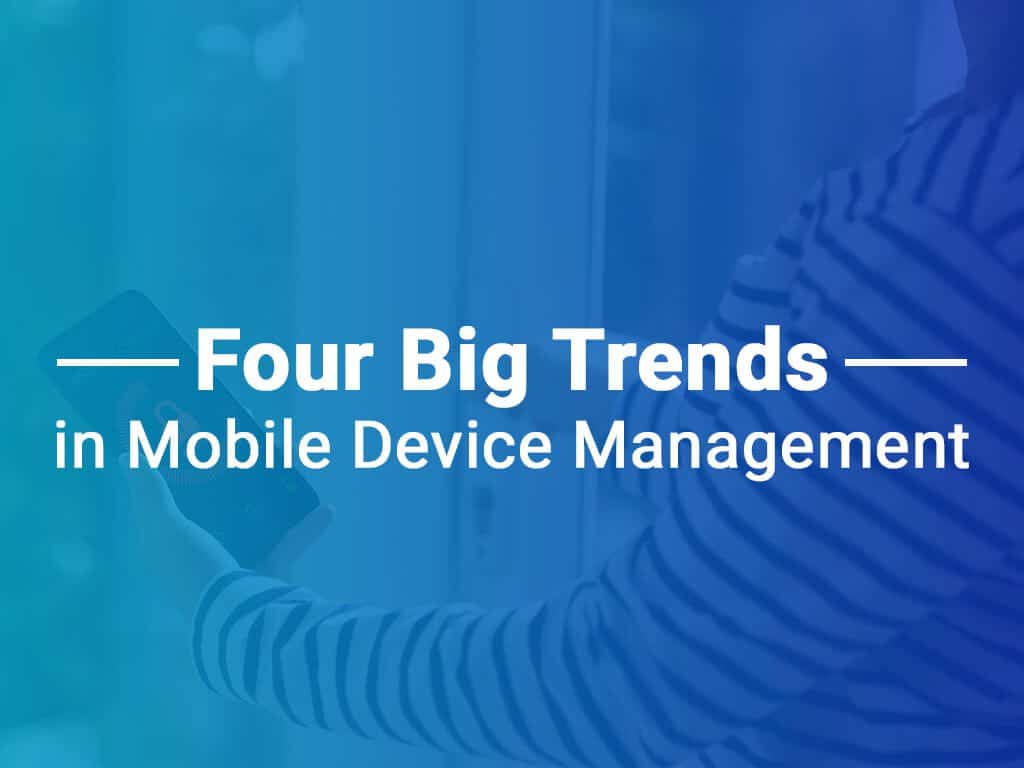
Four Big Trends In Mobile Device Management
Mobility has progressed, in recent years, to the point where some enterprise users hardly ever need to use a laptop or desktop. Many CEOs, for example, only use their phone. Any desktop duties are typically referred to an executive assistant or secretary. Sales jobs, too, can often be accomplished to a greater degree via smartphone.
Certainly, there are many other jobs where this isn’t the case. But regardless of the title, mobile devices are taking up more and more of the enterprise workload. Mobile Device Management (MDM) technology has advanced to provide the processes and tools the mobile workforce needs to stay productive and secure. Further, MDM provides IT with the ability to more easily provision mobile devices, manage them, inventory them, and protect assets and data.
Here are four of the top trends in MDM:
BYOD
Bring Your Own Device (BYOD) was an inevitable consequence of the COVID-19 pandemic. With everyone ordering home almost overnight, IT had no alternative other than to allow employees to use the laptops, desktops, tablets, and smartphones they had at home or used for personal tasks. A few of the lucky organizations (or the ones with deeper pockets) had already provided all employees with a dedicated work laptop, tablet and/or smartphone. By doing that, IT could arrange role-based access to enterprise data and email, and provide services such as a secure VPN, GPS tracking, password-protected applications, and access to a host of enterprise security applications. Beyond that, mobile chaos became the norm. BYOD continues to predominate in many organizations.
This has made MDM a more important field than ever. IT policies may have been relaxed with regard to BYOD. But in tandem, IT has had to up its game in managing mobile devices. MDM has stepped into the breach. Organizations use MDM to remotely enroll personal devices into the enterprise systems. This allows them to monitor behavior, enforce security policies, and facilitate productivity, and detect threats and breaches.
MDM Innovation
The flood of money into MDM tools has encouraged the vendor community to innovate.
MDM solutions are becoming more sophisticated. Machine learning and AI are being incorporated to enable data and systems to be subjected to analysis. MDM systems are appearing that are able to assign or enroll devices with pre-programmed data profiles, VPN access, software, access privileges, and much more. IT now has the ability to track its dispersed workforce more easily, as well as monitor, troubleshoot, and decommission devices when the need arises. Some tools can even wipe device data in the event of theft, loss, or breach.
Virtual Reality
The marriage of MDM and various forms of virtual reality (VR) is opening new doors for field service, maintenance, and technically challenging occupations. For example, augmented reality (AR) tools are emerging that use special glasses, goggles, and headsets that allow field technicians and support personnel to compare physical equipment to digital specifications, job requests, and other information.
As the technician or field rep looks at the object, component, or system, a digital representation appears within their field of vision to verify it is the right valve to inspect, the correct place to weld, or the exact piece of equipment that needs to be removed. The best systems even allow a less experienced person to show a senior engineer (sitting far away) to see the job site so they can walk the other person through the task or answer questions.
MDM Meets Security
MDM has always had some interest in security. It was unavoidable. To manage mobile devices effectively means providing certain safeguards – if only alerting others in the enterprise to a potential situation. MDM is now heading one step further. It is merging more tightly with security applications. Syxsense, for example, provides MDM within a suite that includes integrated patch management, vulnerability scanning, security threat remediation, and IT management. This greatly enhances security while keeping mobile devices safe from malware and other cyber threats. IT can use the Syxsense Enterprise platform to spot anomalous behavior, detect strange activity at ports, at exfiltration attempts, and more.







